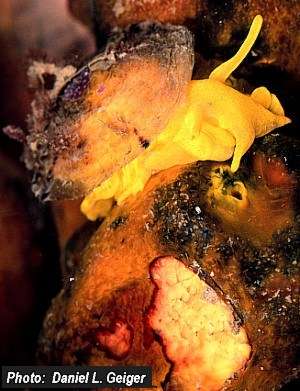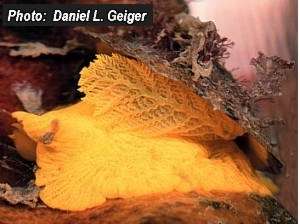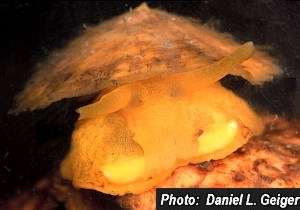
Tylodina perversa
(Gmelin, 1791)
Order: NOTASPIDEA
Superfamily: TYLODINOIDEA
Family: Tylodinidae
DISTRIBUTION
Mediterranean and northeast Atlantic at least as far as British Isles.
PHOTO
UPPER: on food sponge, Aplysina aerophoba [Formerly known as Verongia aerophoba]. See eaten patch below animal.
LOWER LEFT: right side view showing large gill which in all notaspids is found on the right of the body, and in Tylodina and Umbraculum protected by the limpet-shaped shell.
LOWER RIGHT: View of head showing large enrolled rhinophores with small black eyes at their base. Banyuls sur Mer, Mediterranean coast, France, 1991.
PHOTOS: Daniel L. Geiger.
Reference:
• Gmelin, J.R. (1791) Caroli a Linne Systema Naturae per regna tria naturae, Vol. 1, Pt. 6, Cl. 6, Vermes, p. 3021-3910. Leipzig.


Rudman, W.B., 1999 (June 5) Tylodina perversa (Gmelin, 1791). [In] Sea Slug Forum. Australian Museum, Sydney. Available from http://www.seaslugforum.net/find/tyloperv
Related messages
Tylodina perversa from Turkey
May 14, 2010
From: Hakan Kabasakal

Hi,
I observed this specimen of Tylodina perversa, during the long decompression stop at 9 m, after a technical deep dive in Saros Bay (NE Aegean Sea, Turkey).
Locality: Saros Bay, 9 m, Turkey, NE Aegean Sea, 27 April 2009, Inhabits yellow tube sponge. Length: ca. 20 mm longitudinal shell diameter. Photographer: Hakan Kabasakal.
Best regards,
Hakan Kabasakal
hakankabasakal@superposta.com
Kabasakal, H., 2010 (May 14) Tylodina perversa from Turkey. [Message in] Sea Slug Forum. Australian Museum, Sydney. Available from http://www.seaslugforum.net/find/23624
Dear Hakan,
Thanks for this photo. I assume the sponge is Aplysina aerophoba, which is the preferred food of this species. In the close-up photo alongside we can clearly see the dark brown cap-shaped shell. Surrounding the dark brown is a broad band of pale yellow with dark brown radiating bands. This is new shell material. It is much flatter than the older part of the shell and is yet to be covered with plant and animal growths.
Best wishes,
Bill Rudman
Re: Tylodina perversa from Israel
November 11, 2008
From: Dani Barchana

Concerning message #19957:
Tylodina perversa, from Israel, Again.
This is the second time I have seen it. It was spotted by Dr. Yoav Lavy, I just took the picture.
Locality: Beach, 2 meters, Israel, Mediterranean, 07 November 2008, rockery. Length: 3-3.5 cm. Photographer: Dr. Dani Barchana.
Dani Barchana
dani.barchana@gmail.com
Barchana, D., 2008 (Nov 11) Re: Tylodina perversa from Israel. [Message in] Sea Slug Forum. Australian Museum, Sydney. Available from http://www.seaslugforum.net/find/22023
Dear Dani,
Thanks for these photos, which show its external shape very well
Best wishes,
Bill Rudman
Re: Giant Tylodina perversa
July 9, 2008
From: Roberto Pillon

Concerning message #10590:
Dear Marina,
I found a Tylodina perversa very big, like yours.
I think it is about 75 mm.
Locality: Krk Island, 3 metres, Croatia, Mediterranean, 25 June 2008. Length: 75 mm. Photographer: Roberto Pillon.
Roberto Pillon
oderzo@tele2.it



Dear Roberto,
Thanks for the record. It would be interesting to know why we sometimes find these 'giants'. Perhaps they are just individuals that have survived an extra year. I have included close-ups to show the head region and to show the posterior tip of the gill.
Best wishes,
Bill Rudman
Tylodina perversa from the Azores
August 13, 2007
From: David Abecasis

Hello Bill,
I have found this small nudi which I had never seen and I would like some help to identify it.
Locality: Baixa do Sul, Canal Faial-Pico, Azores Islands, 16 meters, Azores islands, Portugal, Atlantic Ocean, 24 July 2007, rocky bottom covered with algae. Length: 5 mm. Photographer: David Abecasis.
Best regards,
David Abecasis
davidbecas@netcabo.pt


Dear David,
This is not a nudibranch, but it is an opisthobranch - Tylodina perversa. As you will see from earlier messages it belongs to a primitive group with a large limpet-like external shell.
Best wishes,
Bill Rudman
Tylodina perversa from Israel
June 8, 2007
From: Dani Barchana

Concerning message #16654:
One of my friends Benjamin Koretz [Opisthobranchs of Eilat], has identified this one for me as Tylodina perversa so I add a sighting from the Mediterranean coast of Israel.
Locality: Michmoret, 2-2.4 meters, Israel, Mediterranean, 24 May 2007, subtidal, rockery. Length: 1.5-1.7 cm.. Photographer: Dani Barchana.
Dani
dani.barchana@gmail.com
Barchana, D., 2007 (Jun 8) Tylodina perversa from Israel. [Message in] Sea Slug Forum. Australian Museum, Sydney. Available from http://www.seaslugforum.net/find/19957Thanks Dani,
Best wishes,
Bill Rudman
Shell-less Tylodina perversa
May 23, 2006
From: Hervé Limouzin

Dear Bill,
I'm French diver, interesting in submarine biology. On a recent dive in the Mediterranean Sea, at Cadaques, Spain, I saw a Tylodina perversa on its Verongia sponge but this specimen did not have the characteristic limpet-shaped shell.
Two days after, when diving at the same place, I saw it again (same animal
on the same sponge) but there was is egg ribbon and I saw the shell, just
close to the Tylodina, on the sponge ! Can Tylodina change shell (annual change ?) or what else ?
Thank you for your answers.
Sincerly
Hervé Limouzin
limouzin.herve@wanadoo.fr
Limouzin, H., 2006 (May 23) Shell-less Tylodina perversa. [Message in] Sea Slug Forum. Australian Museum, Sydney. Available from http://www.seaslugforum.net/find/16654Dear Hervé,
Thanks for this interesting find. It is definitely not usual for these animals to lose their shells. I can only guess that some predator has ripped off the shell and then been deterred from eating the Tylodina by the poisonous chemicals it has in its body. Like many nudibranchs, Tylodina retains metabolites from the sponge it feeds on.
Seeing a shell-less 'limpet' reminds me of an article that was published in The Veliger in the late 1960s or early 70s about a 'clean' way for shell collectors to collect limpets without the bother of removing the animal. It involved walking around the rocks with a gas cigarette lighter. When you found the shell you wanted you gently played the flame over the shell until steam built up between the mantle and the shell and it popped off - leaving the now partly cooked, half alive and naked animal behind! I hope attitudes to collecting have changed.
Best wishes,
Bill Rudman
Tylodina perversa from Turkey
October 8, 2005
From: Goker Goksel

Hi,
Is this Tylodina perversa?
Locality: Guneyli, Saroz, Turkey, Aegean Sea. Depth: 10 m. Length: 30 mm. 04 October 2005. Photographer: Goker Goksel
I found it in a place covered with sea grass. This was the only 'thing' that was not green. I spotted it very easily.
Thank you,
Goker Goksel.
gokerg@yahoo.com
Goksel, G., 2005 (Oct 8) Tylodina perversa from Turkey. [Message in] Sea Slug Forum. Australian Museum, Sydney. Available from http://www.seaslugforum.net/find/14946Dear Goker,
Yes this is Tylodina perversa. Your photo shows the shape of the rhinophores [= head tentacles] and the shell very clearly.
Best wishes,
Bill Rudman
Tylodina perversa from the Mediterranean
January 26, 2005
From: Adrian Valls


Hi,
I saw this specimen in 6 meters of water, on Posidonia, water temp aprox 14C, at 1:00PM on the Costa Brava, specifically Cala Jugadera in Cap de Creus, Spain, just south of France on the Mediterranean.13th Jan 2005
It was around 3-4 cm long, 2 cm tall and 2 wide.
The top is round and conical as seen in the blurry top view, (sorry!) but didn't seem hard. I thought it could be a mantle. The other picture is a view from behind, with our friend heading down and away from the camera.
Any help in identification would be great!
Thanks,
Adrian Valls
avalls108@hotmail.com
Valls, A, 2005 (Jan 26) Tylodina perversa from the Mediterranean. [Message in] Sea Slug Forum. Australian Museum, Sydney. Available from http://www.seaslugforum.net/find/12955Dear Adrian,
I am pretty sure this is the opisthobranchTylodina perversa , which has a conical shell. It's a bit hard to be sure because I can't see any of the head clearly, but the shape of the one set of head tentacles, I can see, look very like those of the rhinophores of Tylodina. Tylodina is a sponge feeder, so if my identification is correct, then it is just crawling over the Posidonia.
Best wishes,
Bill Rudman
Re: Tylodina perversa - chemical defence
July 13, 2004
From: Carsten Thoms
Dear Bill,
I was very pleased to find this well-written summary of our on-going research on the sea slug forum [m9022]. Indeed it is exciting that even after more than a decade of investigations on the ecology of Aplysina sponges, these marine invertebrates are still interesting research objects and still there are many fascinating things to find out about them.
Our studies have continued since your summary in January 2003 and so I would like to update the presented data:
As you have mentioned, Tylodina perversa is a specialist predator on the sponge Aplysina aerophoba and is even able to sequester the alkaloids of its prey selectively into its own tissues (mainly into its hepatopancreas [digestive gland], its mantle and the egg ribbons). Actually the yellow colour of the opisthobranch (and its eggs) is due to the Aplysina aerophoba pigment called uranidine.
When Tylodina individuals are collected from the wild (usually by picking them from Aplysina aerophoba), besides the Aplysina aerophoba metabolites, they almost always contain aerothionin. This is surprising as this brominated alkaloid is not found in Aplysina aerophoba but is characteristic for the second Mediterranean Aplysina species, Aplysina cavernicola. To our knowledge it has not been reported before that Tylodina feeds on Aplysina cavernicola as well. What is more, the habitat of this sponge is restricted either to depths of more than 35 m or to underwater caves. Aplysina aerophoba instead grows in depths between 1 and 15 m. Choice experiments revealed that the slugs do not prefer Aplysina aerophoba when both it and Aplysina cavernicola are available together. Tylodina individuals readily feed on Aplysina cavernicola under laboratory conditions and after two weeks we found the alkaloids of this sponge in all analyzed tissues of the slugs (including the eggs).
On the other hand, in long-term feeding experiments we were able to show that even after five weeks of exclusive feeding on aerothionin-free Aplysina aerophoba, Tylodina individuals still contain almost unchanged aerothionin concentrations. Two different explanations for our findings seem conceivable to us:
•1. Tylodina in its natural environment occasionally feeds on Aplysina cavernicola, and is thereafter able to store aerothionin derived from this sponge for a very long time in its tissue.
•2. Tylodina is able to transform alkaloids derived from Aplysina aerophoba into aerothionin.
We can´t tell yet what the purpose of this selective storage of (or transformation into) aerothionin might be, as in fish feeding experiments, this metabolite revealed to be as strong a feeding deterrent as the brominated alkaloids Tylodina takes up when feeding on Aplysina aerophoba.
Concerning the “microflora” in Aplysina sponges, in collaboration with Dr. Ute Hentschel´s group at the University of Würzburg, we have started to characterize the abundant and diverse bacterial community in tissue of these invertebrates. Transplantation experiments with Aplysina cavernicola revealed an extraordinary stability of this community against changes in environmental conditions. Further we were able to show that bacteria associated with Aplysina cavernicola are members of an ocean-spanning, sponge-specific microbial community that is shared among distantly related sponges from different non-overlapping geographic regions.
For anybody who is interested in more details about our studies, please refer to our institute homepage:
www.uni-duesseldorf.de/WWW/MathNat/PharmBio/Arbeitsgruppe%20Proksch/akpp-neu.htm
or to the following publications:
• Friedrich, A. B.; Merkert, H.; Fendert, T.; Hacker, J.; Proksch, P.; Hentschel.U. (1999). Microbial diversity in the marine sponge Aplysina cavernicola (formerly Verongia cavernicola) analyzed by fluorescence in situ hybridization (FISH). Marine Bioogy, 134: 461-470
• Thoms, C.; Ebel, R.; Hentschel, U.; Proksch, P. (2003) Sequestration of dietary alkaloids by the spongivorous marine mollusc Tylodina perversa. Zeitschrift für Naturforschung, 58c: 426-432
• Thoms, C.; Horn, M.; Wagner, M.; Hentschel, U.; Proksch, P. (2003) Monitoring microbial diversity and natural product profiles of the sponge Aplysina cavernicola following transplantation. Marine Biology, 142: 685-692
•Thoms, C.; Wolff, M.; Padmakumar, K.; Ebel, R.; Proksch, P. (2004) Chemical defense of Mediterranean sponges Aplysina cavernicola and Aplysina aerophoba. Zeitschrift für Naturforschung, 59c: 113-122
For even more details please refer to my PhD thesis (sorry, this is written in German)
http://diss.ub.uni-duesseldorf.de/ebib/diss/show?dissid=859 or email me. I would be happy to answer your questions about our research.
Best wishes,
Carsten Thoms
cathoms@web.de
Thoms, C., 2004 (Jul 13) Re: Tylodina perversa - chemical defence. [Message in] Sea Slug Forum. Australian Museum, Sydney. Available from http://www.seaslugforum.net/find/12689Dear Carsten,
Thanks so much for keeping in touch. The way sea slugs have evolved to remove and modify molecules from their food organisms is a fascinating field of study.
Best wishes
Bill Rudman
Giant Tylodina perversa
July 30, 2003
From: Marina Poddubetskaia


Dear Bill,
Since last year I've seen many Tylodina perversa in Cerbere. There, the usual size of this species is about 3cm. And the largest animal I've seen before was less than 5cm in length. But during the last training course we saw a giant specimen of Tylodina perversa: 75mm in size. It seemed incredible !
Date: July 11, 2003
Location: Cerbere, France, Mediterranean coast
Site: Les Chambres
Depth: 12m
Size: 75mm
Photos: Marina Poddubetskaia - Nembro website
Best wishes,
Marina.
nembro@nembro.info
Poddubetskaia, M., 2003 (Jul 30) Giant Tylodina perversa. [Message in] Sea Slug Forum. Australian Museum, Sydney. Available from http://www.seaslugforum.net/find/10590Dear Marina,
Your comment about a 'giant' reminded me of one large T. corticalis which was found by a colleague here some years ago. It was also about twice the normal size. We don't know enough to be sure but I suspect that species of Tylodina only live for about a year, and these rare 'giants' are animals which have overwintered and are a year older than normal. - but that is just an idea, I have no direct evidence
Best wishes,
Bill Rudman
Tylodina perversa from Turkey
January 26, 2003
From: Ferda Buyukbaykal

Dear Bill,
Could you identify this for me?
Image Data: Bodrum, Mugla, Turkey. October 2002, kargi adasi, 16mt / 1,5-2cm, algae covered rocky.
Best wishes
Ferda
ferdabbaykal@isnet.net.tr
Buyukbaykal, F., 2003 (Jan 26) Tylodina perversa from Turkey. [Message in] Sea Slug Forum. Australian Museum, Sydney. Available from http://www.seaslugforum.net/find/8890Dear Ferda,
This is Tylodina perversa.
Best wishes,
Bill Rudman
Tylodina perversa - chemical defence
January 26, 2003
From: Bill Rudman
While preparing Ferda's message I thought this summary of research on chemical defence in Tylodina perversa and its food sponge would be of interest.
Prof. Proksch's group at the Heinrich-Heine-University in Dusseldorf, Germany is one of many around the world studying the possible ecological functions of natural products found in marine invertebrates. For some years they have been looking at the metabolites of the Mediterranean sponges Aplysina aerophoba and A. cavernicola.
Healthy sponges accumulate brominated isoxazoline alkaloids. These secondary metabolites are highly effective fish deterrents and protect the sponges from predators. However when the sponge is injured these chemicals break down to form smaller molecules with strong antibacterial properties, which probably protect wounded sponges from invasion of bacterial pathogens. The origin of these chemicals in sponges and other marine invertebrates is not clear in many cases. However in Aplysina sponges, where microorganisms make up for up to 40% of the biomass, it is thought that this 'microflora' is responsible for at least some of the secondary metabolites.
Tylodina perversa is probably the last a chain of organisms involved in the production and useof these chemicals. In spite of the presence of these deterrent secondary metabolites in the tissue of Aplysina aerophoba, Tylodina feeds almost exclusively on this sponge. It not only tolerates the defensive metabolites but even sequesters them selectively in its own tissue, probably for defensive purposes against potential predators.
• Ebel, R., Marin, A. and Proksch, P. (1999) Organspecific distribution of dietary alkaloids in the marine opisthobranch Tylodina perversa. Biochemical Systematics and Ecology, 27: 769
• Friedrich, A. B., Fischer, I., Proksch, P., Hacker, J. & Hentschel, U (2001) Temporal variation of the microbial community associated with the mediterranean sponge Aplysina aerophoba. FEMS Microbiology Ecology, 38 105
• Teeyapant, R., Kreis, P., Wray, V., Witte, L. & Proksch, P. (1993). Brominated secondary compounds from the marine sponge Verongia aerophoba and the sponge feeding gastropod Tylodina perversa. Zeitschrift für Naturforschung, 48c: 640
• Teeyapant, R. & Proksch, P. (1993) Evidence for an induced chemical defense of the marine sponge Verongia aerophoba. Naturwissenschaften, 80: 369.
• Teeyapant, R., Woerdenbag, H. J., Kreis, P., Hacker, J., Wray, V., Witte, L. & Proksch, P. (1993) Antibiotic and cytotoxic activity of brominated compounds from the marine sponge Verongia aerophoba. Zeitschrift für Naturforschung, 48c: 939
Best wishes,
Bill Rudman
Tylodina perversa + its egg-ribbon
July 29, 2002
From: Marina Poddubetskaia

Dear Bill,
There are some photos of Tylodina perversa and its egg-ribbon on its favourite sponge Aplysina aerophoba.
Upper right: animal on sponge and [lower left] an egg-ribbon. July 06, 2002, Cerbere, France. Site: Canadells interieur, Depth: 12m
Size: animal 3-4cm, egg-ribbon = 3cm diam.
Lower right: July 01, 2002, Cerbere, France. Site: Les 3 moines, Depth: 13-15m, Size: 4-5cm. Photos: Marina Poddubetskaia - Nembro website
Best wishes,
Marina.
nembro@nembro.info


Thanks Marina,
You certaiunly saw a good variety of opisthobranchs at Cerbere.
Best wishes,
Bill Rudman
Etymology of Tylodina perversa
September 4, 1999
From: Josep Mª Dacosta
To: Dr. Bill RUDMAN
I'm the author of the opistobranch site at M@re Nostrum (http://www.marenostrum.org/opistobranquios)
I have read the information about Tylodina corticalis you have published in the Sea Slug Forum. I would like to ask you a question about Tylodina perversa. What is the etimology of this opisthobranch? I can't find any information related to it. Can you help me?
Yours sincerely
Josep Mª Dacosta
jmdacosta@marenostrum.org
Dacosta. J.M., 1999 (Sep 4) Etymology of Tylodina perversa. [Message in] Sea Slug Forum. Australian Museum, Sydney. Available from http://www.seaslugforum.net/find/1299Dear Josep,
It is possible Gmelin explained why he gave it the name perversa but often the early authors did not. In Latin perversum means 'turned the wrong way' so it may refer to the way the protoconch is turned. If Gmelin compared Tylodina with other limpet shells he would have noticed the protoconch coiled sinistrally (as in all opisthobranchs) rather than dextrally (as in all patellogastropods).
But that is just a guess.
Bill Rudman.
